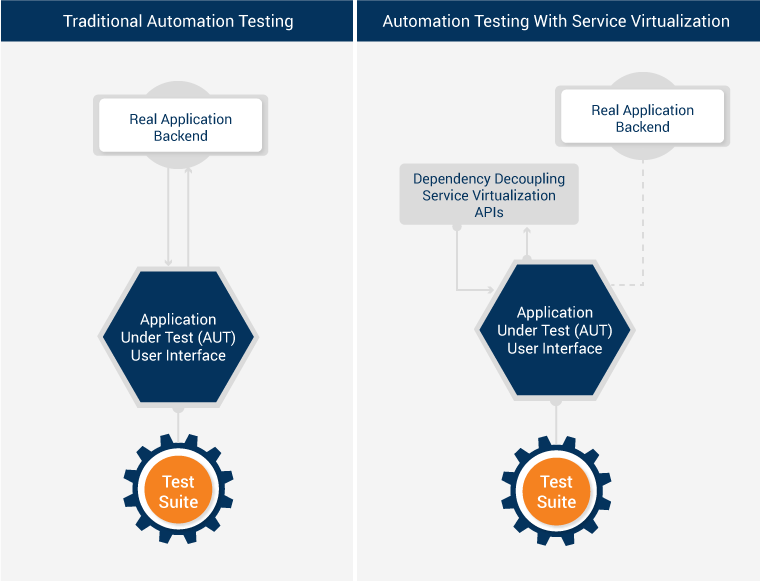An exponential growth in testing has led to new technologies to build better coordination between Dev and QA. Similarly, Service Virtualization has been continuously acquiring its space in the software development life cycle.
Service Virtualization
Service virtualization provides a simulated interface to QA teams, and helps them complete their tests on the application under test (AUT). It is primarily used for testing APIs, Cloud Architectures, and Service Oriented Architecture based applications.
Dev and QA teams can now work together on simulated environments to write test scripts and develop services in parallel which can lead to faster releases.
Rise of Global Service Virtualization Market
with CAGR rising to almost 18.11%

Years
Source: Market Research Future
Architecture

Traditional Automation Testing Vs Service Virtualization

-
Traditional Automation Testing
- Automation dependency on development phase to be completed
- Non-availability of environment as used by many teams in parallel
- Difficult to configure and test unavailable and inaccessible resources
- Delay in mocks, POC demos, and reporting to client
- Environment are often down due to deployment and configuration issue
- Test data setup and lead times problems
-
Automation With Service Virtualization
- Automation goes in parallel with development phase
- Virtual environments are available for QA and Dev teams to work in parallel
- Easy to test unavailable and inaccessible resources
- Simulated environment enables on-time mocks, POC demos, and delivery to client
- Less environment deployment and configuration issues
- Less test data setup and lead time problems
- Increase in test coverage virtual assets
- Enhance the scope of automation testing
- ‘Shift Left’ strategy benefits all the teams
Benefits of Service Virtualization
Reliable Text Execution
Service virtualization enables you to quickly run API tests for load, performance, and functional testing. By simulating the behavior of service requests, testers can develop automated tests as per application’s behavior.
Faster Time To Market
In traditional SDLC approach, the developer has to wait for colleagues and the tester has to wait for the Dev team to finish their tasks. With service virtualization, teams can work in tandem in a simulated environment.
Cost Reduction
Accessing the paid 3rd party APIs for testing could complicate performance tests and can increase the overall cost. Service virtualization simulates these 3rd party APIs and reduces the overall transaction cost and efforts.
Top Service Virtualization Tools
| Wiremock | ReadyAPI | ParaSoft Virtualize | Traffic Parrot | |
|---|---|---|---|---|
|
Virtualization capability
|
A mock server for API service virtualization
|
API service virtualization to create REST & SOAP service
|
API, Web UI, Load Simulation
|
API mocking & service virtualization
|
|
Protocols Supported
|
HTTP based API
|
HTTP, REST, SOAP, JMS, and JDBC
|
HTTP(s), JMS, MQ, TCP/IP, SMTP, FTP/SFTP, and RMI
|
HTTP(s), JMS, IBM MQ, and FTP
|
|
Record & Playback
|
Recording of stubs
|
Recording of HTTPs traffic
|
Recording of dependent components, databases and traffic over HTTP, JMS, & MQ
|
Recording of HTTP SOAP requests, and response
|
|
Availability
|
Open-Source
|
Commercial
|
Commercial
|
Partially Open-Source
|
Conclusion

Service virtualization is an emerging concept that overcomes the limitations of dependent systems and enables the QA engineers to develop end-to-end tests in parallel to the development phase. SQA companies should include this concept in their development lifecycle to speed-up the automation as well as release processes.
Have Suggestions?
We would love to hear your feedback, questions, comments and suggestions. This will help us to make us better and more useful next time.
Share your thoughts and ideas at knowledgecenter@qasource.com


